



Featured image: 144 Hours in Kiev: Instagram montage, all images courtesy of Lev Manovich
Lev Manovich’s upcoming keynote, along with the entire Art of the Networked Practice online symposium, March 31 – April 2, 2015, will be free, open and accessible via web-conference from anywhere in the world. Visit the Website to register. The symposium is in collaboration with Furtherfield.
While big data has infiltrated our everyday lives, Lev Manovich and his collaborators have explored the data of everyday life as a window on social transformation. We discuss his latest work: The Exceptional and the Everyday: 144 Hours in Kiev, a portrait of political upheaval in the Ukraine constructed from thousands of Instagram photos taken over a six day period during the revolution in February of 2014. The project evolves from Manovich’s recent manifestations, Phototrails (2013) and SelfieCity (2014), metamorphosing social media into data landscapes.
Randall Packer: How do you view social media as illuminating a broader understanding of crisis in times of political upheaval?
Lev Manovich: When the media covers exceptional events such as social upheavals, revolutions, and protests, typically they just show you a few professionally shot photographs that focus on this moment of protest at particular points in the city. So we were wondering if examining Instagram photos that were shared in the central part of Kiev would give us a different picture. Not necessarily an objective picture because Instagram has its own biases and it’s definitely not a transparent window into reality, but would give us, let’s say, a more democratic picture. So we’ve downloaded over 20,000 photos shared by 6,000 people, and using visualization we created a number of different views of reality with patterns contained in the data. And we were particularly interested to see how the images of the everyday exist side by side with images of extraordinary events: how images of demonstrations, confrontation with government forces, fire, smoke, and barricades exist next to selfies, parties, or empty streets.
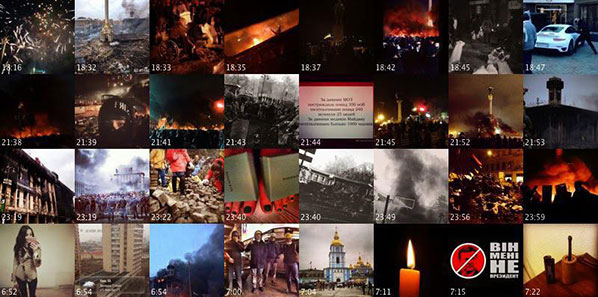
RP: Is it possible to think of what you are doing as taking an activist position in terms of revealing truths about a political situation?
LM: We have to be careful because obviously what you are seeing in 144 Hours in Kiev is a relatively small part of the population. Because the people who do use Instagram create tags mostly in English, they are, maybe, pro-Western people. But it allows us to get a sense of, not necessarily of a truth, not necessarily of what’s real, but let’s say a different kind of picture, a different place of reality then what the journalists would get. Because journalists may go, talk to a few people, and then come up with a report. But here you have “quotes,” so to speak, of thousands of people.
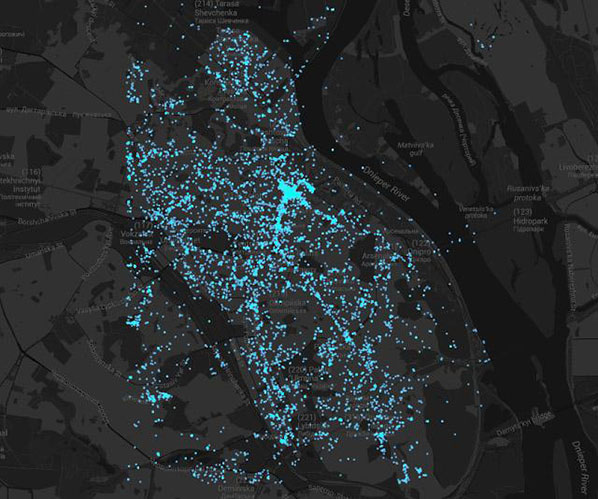
RP: Do you also see the collections of visualizations from user-generated images as an aesthetic realization?
LM: Perhaps one thing we can highlight is the idea of expressive visualization. As an artist I am also interested in the question of how can I present the world through the data. So let’s say a hundred years ago I would be taking photographs of a city. Now I can represent the city through 2 million Instagram photos. Thinking about landscape paintings in Impressionism, Fauvism, or even Cubism, how could I represent nature today through the contributions of millions of people? So I think of myself as an artist who is painting with data.
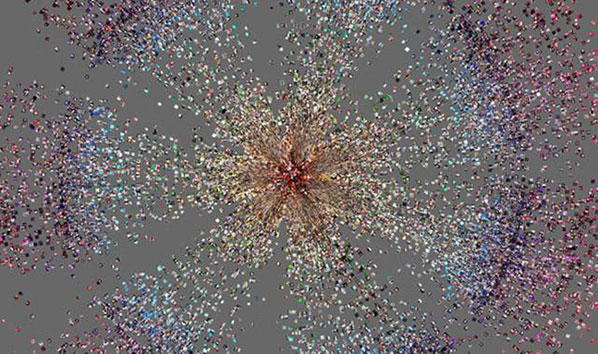
RP: But I’ve noticed that there is a focus in your writing on scientific methodology, you don’t talk very much about the renderings from an artistic perspective.
LM: It’s very clear that we’re taking ideas and techniques that have been used by modern artists. The difference is that we are pulling out data and writing open source tools. We’re taking in this case social media, works that were not created by us, and then putting them through different kinds of combinations. If you think about modernist collage of the city from the 1910s or 1920s, using pieces of newspaper and other existing media, what we’re doing exists in the same tradition.
RP: In many ways, the works can be fully appreciated as collage or composites, which I imagine goes against what you are trying to say through data analysis.
LM: No, it doesn’t go against what we are doing. It’s a matter of speaking to different parts of society. So you don’t just talk to designers or artists or like-minded people, you also talk to scientists. But ultimately what drives me is that I can I create something expressive, something unique, that isn’t just simply a data visualization, but creates an image that finds visual forms, that finds the right metaphors, which allows me to talk about modern society as consistent with its millions of data points. To me I think it’s a successful metaphor for how to speak about society today, when you think about all the traces you leave on social networks. I am trying to find the static visual forms to represent our new sense of society from seemingly random acts of individual people.

RP: Talk about the idea of “collective stories,” which are revealed in the composite of hundreds of thousands Instagram photos, each of which is a story in and of itself.
LM: We bring all these narratives together and try to make a kind of composite “film.” The connection to documentary, such as filmmakers like Dziga Vertov, for me is very clear. When Dziga Vertov, for example, was making his films in Kiev, he would have several cameramen in different parts of the Soviet Union shooting everyday, and they would send it to him and he would put it all together. So my “films” are made up of downloaded visuals, in which you can then make multiple “films” out of.
RP: Is it possible that the individual stories, the individual voice of expression, might get lost in this broad swath of data mining and cultural analytics?
LM: People are documenting what they think is interesting and important in their lives. But because there are very particular behaviors, what you get is a kind of pattern. I would say that patterns are not the same thing as a story. I don’t think of it as traditional narrative art, but rather a pattern of certain repeating behaviors.
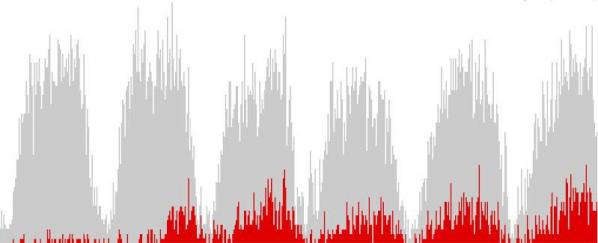
RP: How do you position the work you are doing in the context of the current crisis of invasive surveillance and the loss of privacy resulting from big data analysis?
LM: When we started thinking about these ideas in 2005, these issues were not on the table. In the last two or three years they have become central and to be honest they keep me up at night. I consider whether or not it’s OK because there are histories of governments using photographs of protests of honest people. I think the first time it happened seriously was in Prague in 1968 when it was raided by the Soviet Union. You had bystanders taking pictures, and when the pictures were found they were used to arrest people. So we thought a lot about it. When you start to individualize stories, when you start following particular people, then it gets really dangerous.
RP: In this sense its a very political project. What you have done is revealed that in the 21st century of social media it’s difficult to hide anything. What have you learned about contemporary life as seen through the lens of social media?
LM: This is a deep question. I’m basically trying to say that as opposed to a journalist who thinks about the “data” as a kind of truth, that it’s a way to find out what happened, what I’m thinking about is its own reality. It’s not a question of truth, it’s a question of making interesting connections.
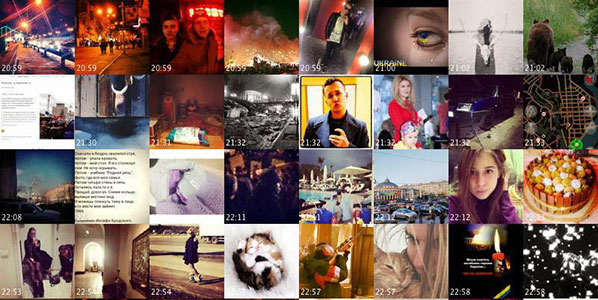
RP: That’s the difference between an artist and a journalist or even a scientist. You’re absorbing and you’re finding the connections but you’re not trying to say: this is it.
LM: I think the main answer is this: we can produce different visualizations out of the same data. Everyone views a different idea. It’s like when Monet paints another cathedral, there is not one painting that is correct. He makes a dozen paintings where every painting represents a different color, different atmospheric conditions, to show that in fact there are only the subjective views. So the goal is perhaps not to give people a new interpretation, but rather to challenge what they may be thinking is the correct one.
The Everyday and the Exceptional: 144 Hours in Kiev is a project of Lev Manovich in collaboration with Dr. Mehrdad Yazdani, Alise Tifentale, and Jay Chow.